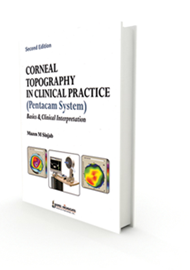This book is based upon one device, the Pentacam, developed by OCULUS, and is primarily aimed at those who wish to familiarise themselves with the Pentacam system and need a text to complement the instrument operations manual.
It is laid out in six sections beginning with a short introduction, followed by a concise chapter on the basic anatomy of the eye with an overview of several instruments that can be employed to measure corneal topography. The fundamentals of corneal topography as applied in the Pentacam system are briefly presented with a description of the various functions available from the software and how they are displayed. Wavefront analysis of ocular refractive surfaces and densitometry is mentioned. Detecting keratoconus, recognising its progression if considering corneal cross-linking treatment and performing topographic screenings prior to refractive surgery are potentially hot topics, so the section on keratoconus and keratoectasia will prove especially useful for those practitioners new to the subject.
A key feature of the Pentacam system is its ability to provide an accurate map of the entire anterior and posterior surfaces of the cornea from limbus to limbus. Several examples of typical topographical patterns are depicted, and a section is dedicated to the common causes of artefacts and their interpretation. The final section deals with those topographical patterns characteristic of irregular astigmatism and corneal topography pertinent to cataract surgery, where choice of incision and intraocular lens (IOL) type can be tailored to individual patients.
The quality of the colour images in this book is exemplary, including slit-lamp photographs, Scheimpflug images and computer-generated surface maps and diagrams. Many examples are shown using captured images obtained from the Pentacam system including the respective numerical data, clearly readable, adjacent to each of the maps. Attention to detail in page layout aids navigation throughout the volume.
The main criticism of this otherwise well-presented book is its lack of references for each chapter, with the bibliography at the end of the book limited to just 37 entries. Several of the articles referenced are taken from a single international conference, namely the European Society of Cataract and Refractive Surgeons, Sweden, 2007. For those not familiar with Scheimpflug photography, the description of the Pentacam unit may seem too brief and would benefit from additional referenced material in the bibliography.
Experienced corneal specialists are likely to find the text too basic, but junior colleagues, ophthalmic nurses, newly-qualified optometrists involved in corneal clinics and biometrists should find a refreshing insight provided by the clear descriptions and notes on the clinical interpretation of the illustrations.




